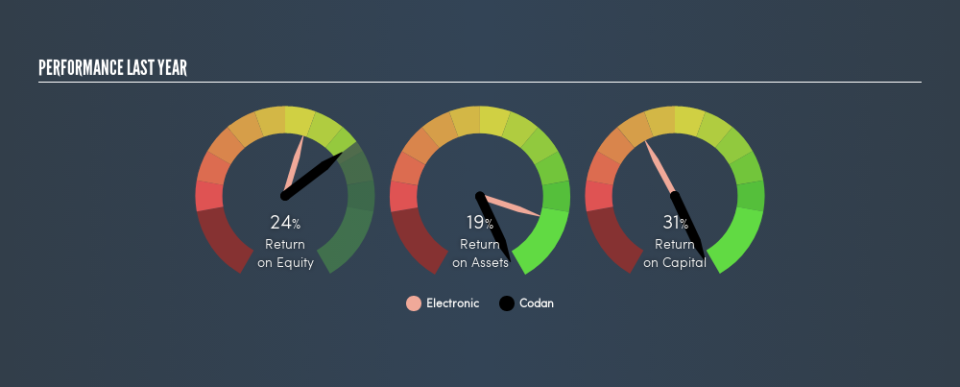What Can We Make Of Codan Limited’s (ASX:CDA) High Return On Capital?

Today we are going to look at Codan Limited (ASX:CDA) to see whether it might be an attractive investment prospect. To be precise, we'll consider its Return On Capital Employed (ROCE), as that will inform our view of the quality of the business.
Firstly, we'll go over how we calculate ROCE. Second, we'll look at its ROCE compared to similar companies. Then we'll determine how its current liabilities are affecting its ROCE.
Understanding Return On Capital Employed (ROCE)
ROCE measures the amount of pre-tax profits a company can generate from the capital employed in its business. All else being equal, a better business will have a higher ROCE. Ultimately, it is a useful but imperfect metric. Renowned investment researcher Michael Mauboussin has suggested that a high ROCE can indicate that 'one dollar invested in the company generates value of more than one dollar'.
How Do You Calculate Return On Capital Employed?
The formula for calculating the return on capital employed is:
Return on Capital Employed = Earnings Before Interest and Tax (EBIT) ÷ (Total Assets - Current Liabilities)
Or for Codan:
0.31 = AU$63m ÷ (AU$249m - AU$45m) (Based on the trailing twelve months to December 2018.)
Therefore, Codan has an ROCE of 31%.
See our latest analysis for Codan
Does Codan Have A Good ROCE?
ROCE can be useful when making comparisons, such as between similar companies. Codan's ROCE appears to be substantially greater than the 10% average in the Electronic industry. We would consider this a positive, as it suggests it is using capital more effectively than other similar companies. Setting aside the comparison to its industry for a moment, Codan's ROCE in absolute terms currently looks quite high.
In our analysis, Codan's ROCE appears to be 31%, compared to 3 years ago, when its ROCE was 8.6%. This makes us think about whether the company has been reinvesting shrewdly. You can see in the image below how Codan's ROCE compares to its industry. Click to see more on past growth.
Remember that this metric is backwards looking - it shows what has happened in the past, and does not accurately predict the future. Companies in cyclical industries can be difficult to understand using ROCE, as returns typically look high during boom times, and low during busts. This is because ROCE only looks at one year, instead of considering returns across a whole cycle. What happens in the future is pretty important for investors, so we have prepared a free report on analyst forecasts for Codan.
What Are Current Liabilities, And How Do They Affect Codan's ROCE?
Liabilities, such as supplier bills and bank overdrafts, are referred to as current liabilities if they need to be paid within 12 months. The ROCE equation subtracts current liabilities from capital employed, so a company with a lot of current liabilities appears to have less capital employed, and a higher ROCE than otherwise. To counteract this, we check if a company has high current liabilities, relative to its total assets.
Codan has total assets of AU$249m and current liabilities of AU$45m. As a result, its current liabilities are equal to approximately 18% of its total assets. A minimal amount of current liabilities limits the impact on ROCE.
Our Take On Codan's ROCE
With low current liabilities and a high ROCE, Codan could be worthy of further investigation. Codan looks strong on this analysis, but there are plenty of other companies that could be a good opportunity . Here is a free list of companies growing earnings rapidly.
If you are like me, then you will not want to miss this free list of growing companies that insiders are buying.
We aim to bring you long-term focused research analysis driven by fundamental data. Note that our analysis may not factor in the latest price-sensitive company announcements or qualitative material.
If you spot an error that warrants correction, please contact the editor at editorial-team@simplywallst.com. This article by Simply Wall St is general in nature. It does not constitute a recommendation to buy or sell any stock, and does not take account of your objectives, or your financial situation. Simply Wall St has no position in the stocks mentioned. Thank you for reading.

 Yahoo Finance
Yahoo Finance 
